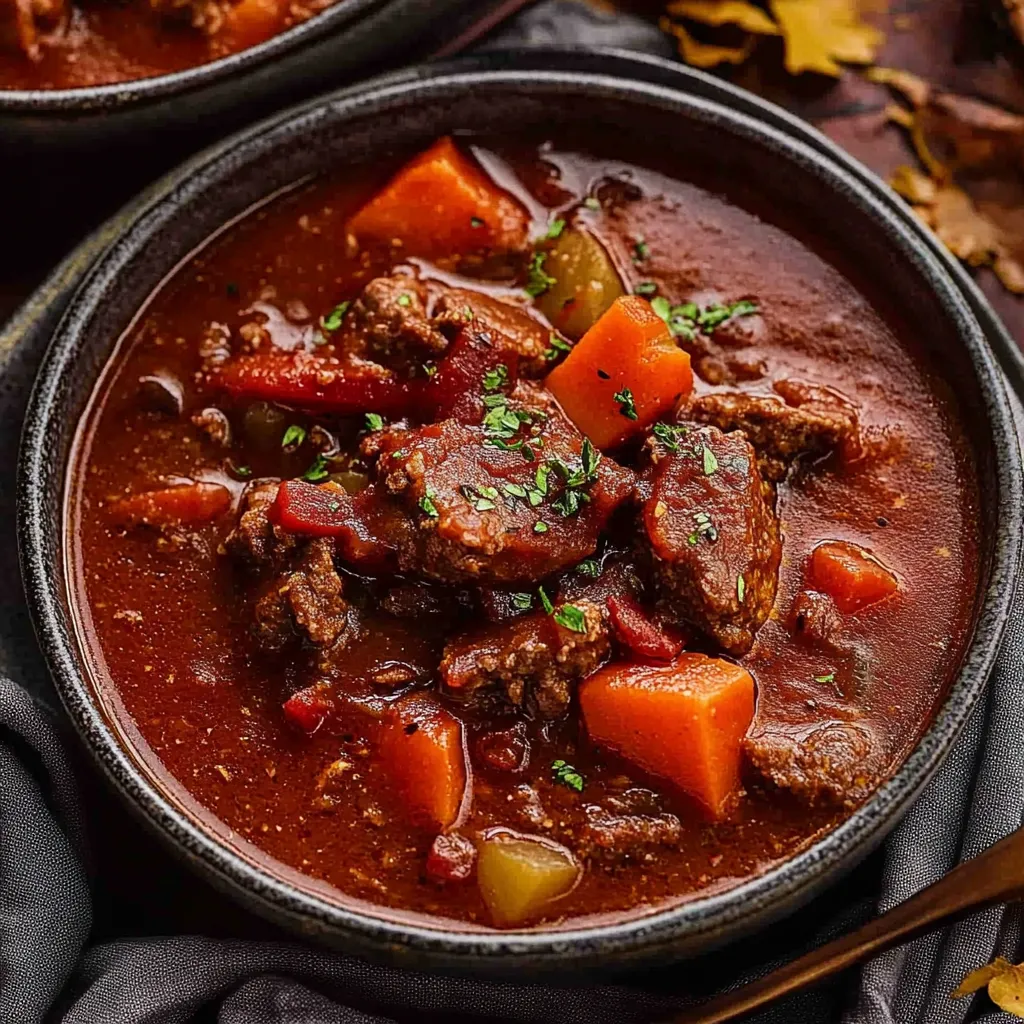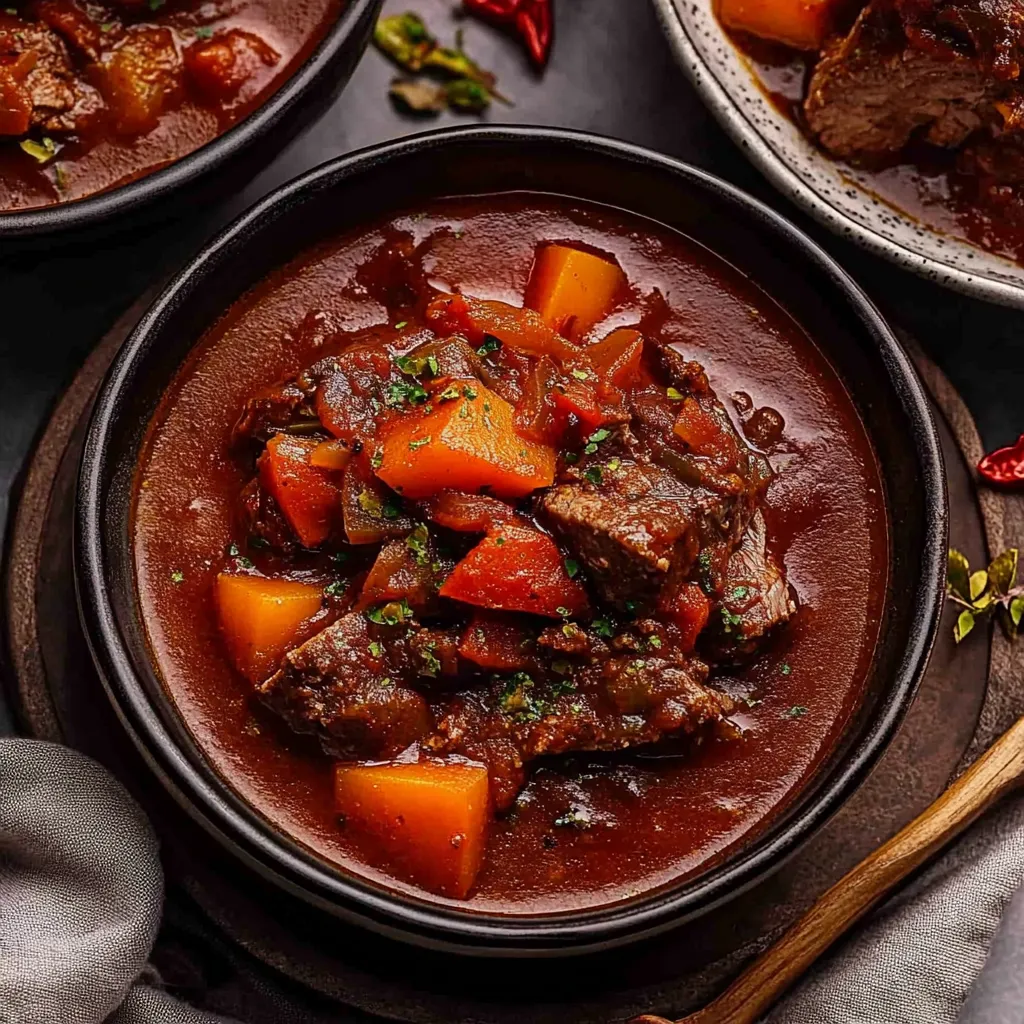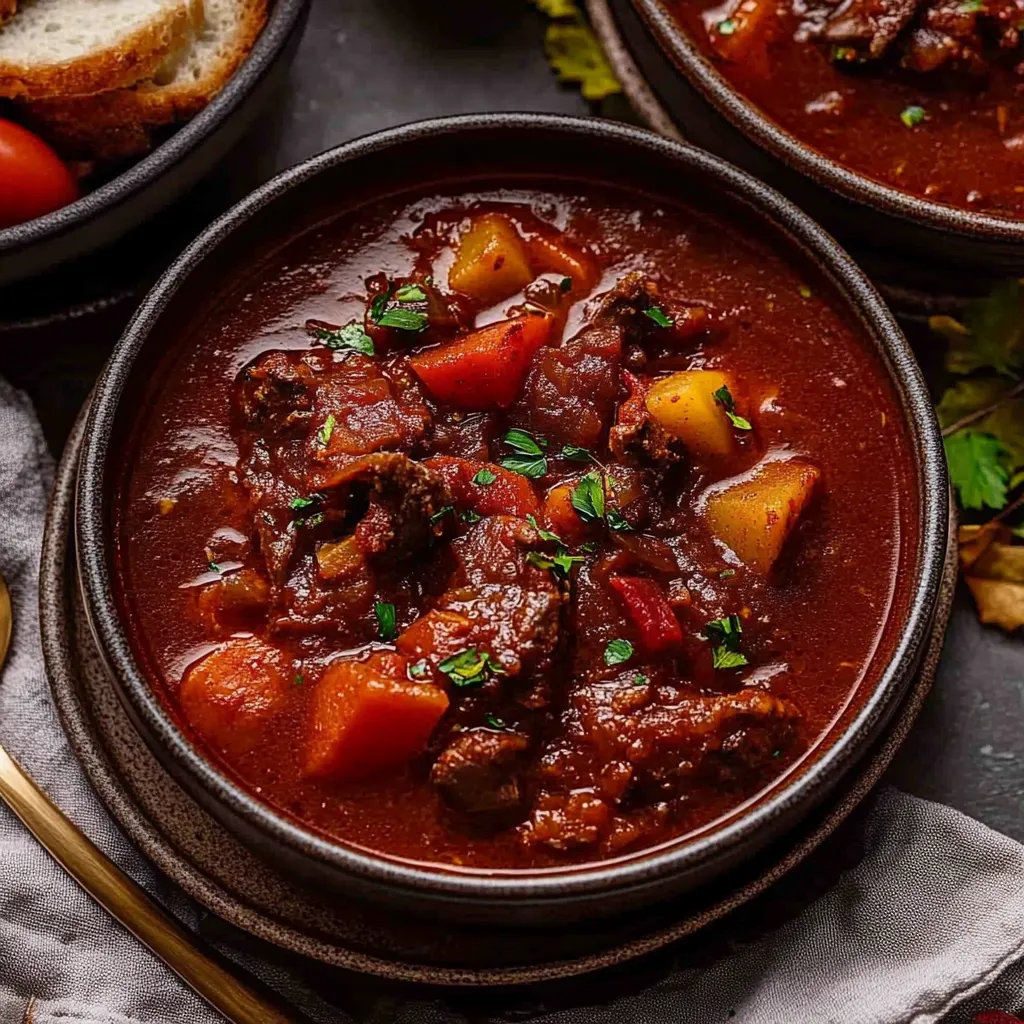 Pin it
Pin it
Hungarian goulash is the kind of soul-warming simmered stew that fills your kitchen with the most delicious aromas and makes coming together at the table feel special. Slowly braised cubes of beef mingle with sweet onions smoky paprika bright bell peppers and soft hunks of potato for a one pot wonder that is every bit as comforting as it is flavorful.
The first time I made this as a new parent after a chilly walk in the park my whole family lingered around the oven waiting for dinner to be ready and it quickly became our go to Sunday supper when everyone craves some extra warmth.
Ingredients
- Beef chuck: Delivers rich beefy flavor and turns buttery tender as it braises, look for well marbled pieces from your butcher
- Cooking salt or kosher salt: Boosts flavors throughout the stew, use a flaky or coarse variety for the best results
- Black pepper: Adds background warmth and balances the sweetness of the paprika, choose freshly cracked for a fresher bite
- Extra virgin olive oil and unsalted butter: Combine for savory depth and a bit of silkiness to the onions
- Brown onions: Become meltingly soft and sweet, forming the base of the sauce, pick heavy firm bulbs with papery skins
- Garlic cloves: Infuse aromatic goodness, mince finely to avoid bitter chunks
- Red and yellow bell peppers: Lend color brightness and gentle sweetness, choose thick walled and shiny peppers for best results
- Fresh tomatoes: Break down to create a natural sauce, use well ripened fruit for juiciness
- Hungarian style paprika: Gives authentic smoky notes to the dish, go for a deep red color and fragrant aroma
- Caraway seeds: Offer subtle earthy and nutty flavor, though optional they bring a real Hungarian dimension
- Bay leaf: Imparts woodsy herbal character to the broth, use whole dried leaves
- Beef stock or low sodium beef broth: Is the liquid base, opt for a quality broth that is not too salty
- Carrots: Bring sweet earthiness and add another layer of heartiness
- Potatoes: Make each serving extra comforting, waxy or all purpose potatoes hold their shape best
- Finely chopped parsley: Brightens and freshens up each bowl as a final touch
Step-by-Step Instructions
- Preheat and Prepare Oven:
- Set your oven to 180C or 350F or 160C for fan ovens. This helps achieve a gentle even braise that softens the beef gradually and melds flavors. You can also use a slow cooker or stovetop but the oven method is reliable for even heating
- Season the Beef:
- Scatter half the salt and pepper over beef cubes in a large bowl. Toss them so the seasoning touches each piece thoroughly. This step builds foundational flavor in every bite
- Sauté the Onions:
- Heat the olive oil and butter together in a large oven proof Dutch oven over high heat. When butter sizzles add the onions. Cook for about 6 minutes stirring frequently until onion edges become lightly golden and translucent. The golden onions will form the sweet backbone of your broth
- Brown the Beef:
- Add the seasoned beef to the pot. Stir to coat with the onions and cook just until the outside of the beef loses its raw redness and turns brown. It is not meant to be deeply seared since the focus here is on slow braising not crusty edges
- Build the Vegetable Base:
- Toss in the finely minced garlic diced bell peppers and tomato wedges. Stir this mixture over high heat for around 3 minutes just until the peppers start softening and tomatoes begin to break down forming a rustic sauce
- Add the Spices:
- Sprinkle in paprika caraway seeds if using and the bay leaf. Stir well for about 30 seconds releasing the essential oils from the spices and developing the iconic red color
- Begin the Braise:
- Pour in your beef stock or broth and stir to combine. Bring the mixture to a gentle simmer not a boil. Then cover the pot with a tight fitting lid and carefully transfer to the preheated oven. Let this bubble away for 90 minutes for fabulously tender beef and perfect flavor melding
- Incorporate the Root Vegetables:
- After 90 minutes check the beef it should be soft but not quite falling apart. Add your carrot quarters and potato cubes to the pot folding them gently into the stew. Return to oven for another 30 minutes covered. When time is up your beef should now yield effortlessly to a fork and the potatoes will be silky and cooked through
- Finish and Serve:
- Ladle the goulash into deep bowls scooping up plenty of beef veggies and broth in every serving. Sprinkle generously with freshly chopped parsley. Serve hot and if you wish offer warm rustic bread on the side to mop up the rich red sauce
 Pin it
Pin it
My favorite ingredient is the Hungarian paprika one whiff brings back memories of my grandmother’s kitchen where she always let me sprinkle it into the simmering goulash. The deep earthy color and smoky sweetness are what set this dish apart and make it unforgettable to my family
Storage Tips
Let the goulash cool completely before placing in airtight containers. It will keep in the fridge for up to four days and reheats beautifully on the stovetop or in the microwave. For longer storage freeze portions for up to three months then thaw overnight in the fridge.
Ingredient Substitutions
If you cannot locate Hungarian style paprika a good quality smoked or sweet paprika works in a pinch. For a vegetarian version swap beef for cubed mushrooms and use vegetable stock. Try parsnips or sweet potato in place of carrots if you prefer a subtle twist.
Serving Suggestions
Enjoy goulash as a main dish with nothing more than a sprinkle of parsley or ladle it over buttered noodles or fluffy mashed potatoes. A tangy cucumber salad or a thick slice of sourdough bread with cheese make excellent accompaniments for soaking up the rich sauce.
 Pin it
Pin it
Enjoy every spoonful of this cozy Hungarian goulash with someone you love. It is the kind of dish that gathers people around the table and makes an ordinary evening feel special.
Frequently Asked Questions
- → What type of beef works best for Hungarian goulash?
Beef chuck is ideal due to its marbling and ability to become tender during slow cooking. Cubes around 3.5 cm / 1.5 inches are recommended.
- → Is Hungarian paprika necessary?
Hungarian-style paprika imparts authentic flavor and vivid color. If unavailable, ordinary paprika can be used, but the taste may be milder.
- → What vegetables are essential for traditional goulash?
Common additions are potatoes, carrots, onions, tomatoes, and bell peppers, which provide sweetness and texture to the broth.
- → How should the dish be served?
Serve hot in bowls, garnished with fresh parsley. Rustic bread makes an excellent accompaniment for soaking up the broth.
- → Can this be made on the stove or slow cooker?
Yes, while oven method is preferred for even cooking, stove and slow cooker adaptations work well with slight adjustments to timing.
